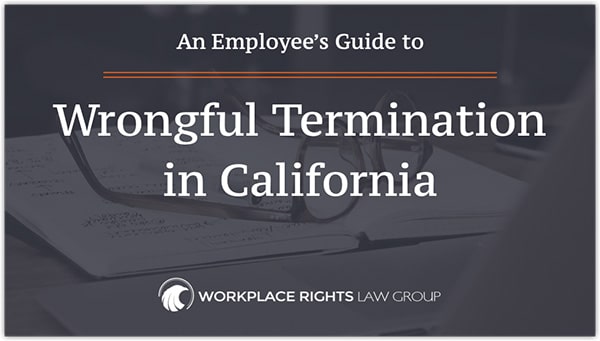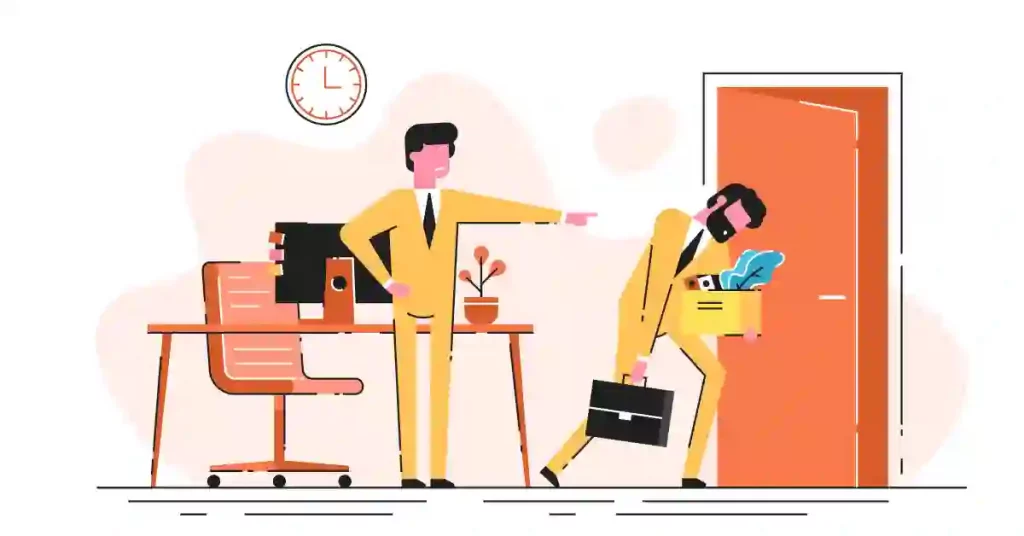Wondering Whether You May Have a Valid Wrongful Termination Claim in California? You’re in the Right Place.

Every day employees get fired by their employers. Sometimes it is for poor work ethic, lack of skill, or some other reason.
In California, firing an employee is legal for the most part. As an “at-will” state, both the employer and employee can end the working relationship at any time and without notice.
However, when an employer fires an employee for the wrong reasons—illegal reasons—you have the right to file a wrongful termination claim.
Workplace Rights Law Group has decades of combined experience dealing with wrongful termination cases in California. We are proud of the results we’ve been able to achieve in partnership with our clients.
This guide discusses California law and the limits on employers’ abilities to fire an employee. We’ll look at what’s important to consider when you believe you may have been wrongfully terminated by an employer in California.
For immediate assistance, please don’t hesitate to send us a message or call (818) 844-5200.
Keep reading to learn more about wrongful termination in California or jump to a topic below.
A Guide to Wrongful Termination Claims in California
- Chapter 1: What Is Wrongful Termination?
- Chapter 2: Who Qualifies as An Employee in California?
- Chapter 3: Does It Matter That You Are An “At-Will” Employee?
- Chapter 4: Unique Types of Wrongful Termination Cases
- Chapter 5: Steps to Take When You Have Been Terminated in California
- Chapter 6: Damages in California Wrongful Termination Claims
Information About WRLG Attorneys
CALIFORNIA WRONGFUL TERMINATION GUIDE
Chapter 1: What is Wrongful Termination Law in California?

Wrongful termination in California happens when an employment agreement is ended by the employer in violation of the employee’s legal rights.
An employee who has been terminated for discriminatory reasons, for exercising their legal rights, or in violation of an employment contract may have a wrongful termination claim.
Wrongful termination happens when an employment agreement is ended by the employer in violation of the employee’s legal rights.
Even though California is an “at-will” state, meaning that an employer or employee can be terminated at any time with or without cause at any time and for any lawful reason, with or without advance notice.
Nevertheless, in California, wrongful termination claims come when state and federal laws explicitly prohibit employers from firing employees for a number of reasons, which are illegal.
Discharge of an employee for an unlawful reason is a wrongful termination according to California termination laws.
Anti-Discrimination: Federal and California State Laws
The laws setting forth anti-discrimination practices are found in Title VII of the federal Civil Rights Act of 1964, the California Fair Employment and Housing Act (FEHA), the Age and Discrimination Act (ADEA), the Equal Pay Act, the Americans with Disabilities Act (ADA), the California Family Rights Act, and the Healthy Workplaces, Healthy Family Act.
Discrimination claims are handled by both the California Department of Fair Employment and Housing (DFEH) and the federal Equal Employment Opportunity Commission (EEOC).
Federal Employment Discrimination Protected Classes
Under federal law, an employee cannot be fired for the following:
- Age (40 or older);
- Race;
- Sex (including pregnancy, gender identity, and sexual orientation);
- Physical disability;
- Mental disability;
- Religion or religious practices;
- National origin; and
- Political affiliation.
Federal law provides the minimum protections required of employers.
California Employment Discrimination Protected Classes
California has some of the most comprehensive and protective laws for employees in the nation. In California, an employee cannot be fired for:
- Race, color,
- Ancestry, national origin,
- Religion, creed,
- Age (over 40),
- Disability, mental and physical,
- Sex or gender (including pregnancy, childbirth, breastfeeding or related medical conditions),
- Sexual orientation,
- Gender identity, gender expression,
- Medical condition,
- Genetic information,
- Marital status, and
- Military and veteran status.
Harassment and Retaliation
The Fair Employment and Housing Act (FEHA) makes it illegal for employers to discriminate against an employee or retaliate against them because they have asserted their rights under the law. Learn more about FEHA here.
Examples of retaliation include firing someone for:
- Reporting unlawful activities;
- Claiming workers’ comp;
- Making a workplace health or safety complaint;
- Complaining about unpaid wages or overtime;
- Reporting Labor Code violations, such as failure to provide meal or rest breaks;
- Reporting patient safety concerns (health care workers); and
- Filing an OSHA complaint.
Taking Protected Family Time Off
The California Family Rights Act (CFRA) requires employers with 50 or more employees to provide eligible employees with up to 12 weeks of job-protected leave in a 12-month period for the birth of a child or for placement of a child in the employee’s family for adoption or foster care.
The Family Rights Act also requires leave for the serious health condition of the employee’s child, parent, or spouse, and for the employee’s own serious health condition. Learn more about paternity leave law in California here.
Sick Leave
Under the Healthy Workplaces, Healthy Family Act, eligible employees may take paid sick leave for the following reasons:
- Diagnosis, care or treatment of the employee’s or a covered family member’s existing health condition;
- Preventive care for the employee or a covered family member; and
- For an employee who is a victim of domestic violence, sexual assault or stalking to obtain legal, medical or social services.
Employees may accrue and use up to 24 hours (or three days) of paid sick leave per year. Total accrual, including carryover of unused accrued time, may not exceed 48 hours (or six days) per year.
Were You a Victim of Wrongful Termination? Get Answers
If you believe you were wrongfully terminated from your job, we want to hear about it. Briefly tell us about the details of what happened and then we look over it for free. At WRLG, we have a dedicated team of experts with wrongful termination cases and want to help you.
A GUIDE TO WRONGFUL TERMINATION IN CALIFORNIA
Chapter 2: Who Qualifies as An Employee in California?

Understanding who falls into the employee category, as opposed to being a California independent contractor, can be confusing. But the distinction is a very important one because only an employee may file a wrongful termination claim in the state of California.
Fortunately, the California Labor Code and recent case law spell out the differences between an employee and an independent contractor.
Employee vs. Independent Contractor in California
Who is an Employee in California?
An employee typically works at the company’s place of business, has set hours, performs work that is part of the company’s regular business.
They also receive training and direction from the company, and receives an hourly wage or salary. Further, the company has control over how the work is performed.
Under both federal and state law, employees get offered a variety of protections, including federal and state anti-discrimination laws. These protections provide the grounds for an employee to file a wrongful termination claim.
Who is an Independent Contractor in California?
In contrast with an employee, California defines an independent contractor as “any person who renders service for a specified recompense for a specified result, under the control of his principal as to the result of his work only and not as to the means by which such result is accomplished.”
An independent contractor is hired to do a specific job with a specific result and has full control over how the work will be completed.
The California Supreme Court recently expanded the definition of “employee” making it more difficult for employers to claim that the person doing work for them is an independent contractor.
Under the new standard, to establish that an individual is, in fact, an independent contractor, an employer must prove that:
- It does not control how the individual performs the work;
- The individual provides a service that is not part of the employer’s usual business; and
- The individual customarily engages in an established business, trade, or profession that is independent of the employer’s business.
California independent contractors may not file a wrongful termination claim.
WRONGFUL TERMINATION IN CALIFORNIA
Chapter 3: Does It Matter That You Are An “At Will” Employee?

Most California Employees Are “At-Will” Employees
Like the majority of other states, California is an “at-will” employment state, and most California employees are “at-will”.
This means that employers do not need to provide justification for their decision to terminate employment, and employees are free to leave their job at any time.
If an employee is “at-will,” the employer generally can terminate the employment at any time and for any reason or no reason at all.
In contrast, when employment is “for cause,” rather than “at-will” the employer needs a good reason for terminating the employee. In California, good cause exists when the employee fails to perform the responsibilities of the job.
“At-Will” Employment Is Not an Excuse for Unlawful Termination
Employers cannot break anti-discrimination laws or retaliate against an “at-will” employee for asserting their legal rights.
Employees who are fired for discriminatory reasons, for exercising their legal rights, or in violation of an employment contract may have a wrongful termination claim.
Under the California Fair Employment and Housing Act, there are clearly defined situations where an employer may have illegally terminated employment.
Termination on the basis of any of the following would be considered unlawful:
- Age discrimination;
- Criminal conviction discrimination;
- Disability discrimination;
- Ethnicity discrimination;
- Family responsibility discrimination;
- Gender/sex discrimination;
- Hostile work environment;
- Medical condition discrimination;
- Military status discrimination;
- National origin discrimination;
- Pregnancy discrimination;
- Race discrimination;
- Religious discrimination;
- Sex-stereotyping discrimination;
- Sexual harassment;
- Sexual Orientation Discrimination;
- Transgender discrimination;
- Political affiliation;
- Constructive termination – hostile work environment;
- Retaliation for workplace health and safety complaints;
- Retaliation for complaining about unpaid wages or overtime;
- Retaliation for reporting Labor Code violations, such as failure to provide meal or rest breaks;
- Retaliation against health care workers for reporting patient safety concerns; or
- OSHA retaliation.
Termination on the basis of any of the above would be considered unlawful.
Contractual Agreements
Even though most employment agreements are presumed to be “at-will,” some employment arrangements are clearly defined within a contract.
The contract will spell out the terms of employment such as duration of employment and the protection from termination “without cause.”
This means that an employer cannot fire an employee without a good reason. This is different than “at-will” employment, which allows an employer to fire an employee for any legal reason, whether it’s a good reason or not.
Having a contract may provide grounds to file a claim, but it does not guarantee that the employee will win their case.
If an employee has either a written on implied contract with an employer and is terminated before the end of the agreed-upon time, they have the right to seek compensation for their losses based on a wrongful termination or breach of contract.
If an employer breaks an employment contract, an employee is entitled to what they should have received under its terms.
CALIFORNIA WRONGFUL TERMINATION CLAIMS GUIDE
Chapter 4: Unique Types of Wrongful Termination Cases

Not all termination cases are clear cut. Sometimes there may be an argument for both wrongful and lawful termination within the same claim.
This is known as a mixed-motive termination. In other cases, an employee may have resigned before being fired because the workplace became so intolerable that the employee had no other choice but to resign. This is known as constructive discharge.
In both of these instances, you may have a claim for wrongful termination.
Were You a Victim of Wrongful Termination? Get Answers
If you believe you were wrongfully terminated from your job, we want to hear about it. Briefly tell us about the details of what happened and then we look over it for free. At WRLG, we have a dedicated team of experts with wrongful termination cases and want to help you.
Mixed Motive Termination
A mixed-motive termination is when the employer has both unlawful motives and a legitimate reason for firing the employee. When an unlawful reason is a substantial motivating factor in the decision, the termination is wrongful.
If the employer was motivated by any unlawful factors in deciding to terminate an employee, even in part, then the employee may have a valid legal claim for damages.
The plaintiff has to prove that discrimination was a substantial factor motivating his or her termination. The employer then has the burden to prove that they had legitimate, nondiscriminatory reasons to terminate employment.
If the employer can prove that it would have made the same termination decision for lawful reasons, then the plaintiff cannot be awarded damages, back pay, or an order of reinstatement. Where appropriate, the plaintiff may be entitled to declaratory or injunctive relief.
This is meant to deter employers from acting unlawfully, even if discrimination only played a small or minor role in the decision. The plaintiff may also be eligible for an award of reasonable attorney’s fees and costs.
Constructive Discharge
According to California employment law, constructive discharge is when an employer intentionally creates intolerable working conditions for an employee and they have no choice but to resign.
Intolerable Conditions
An employee is protected from unreasonably harsh working conditions in excess of those faced by other co-workers. However, the employee is not guaranteed a working environment free of stress. Intolerable working conditions must be extreme or part of a continuous pattern.
To prove constructive discharge in California, an employee must prove two things:
- The working conditions were unusually intolerable and a reasonable employee would feel compelled to resign; and
- The employer either intended to force the employee to quit or had knowledge of the conditions and did nothing about it.
An employee who is constructively discharged may be able to bring a wrongful termination claim as if the employer had fired the employee directly.
CALIFORNIA WRONGFUL TERMINATION LAWSUIT GUIDE
Chapter 5: Steps to Take When You Have Been Terminated in California

Being fired is a scary and stressful time for an employee. It is easy to get lost in the chaos of emotions and fears surrounding the termination.
Fortunately, there are clear processes in place to help navigate the legal system and to secure employee rights.
Information Gathering
As soon as the employee is terminated and if they believe that it was unlawful in any way, they should start to gather any and all information and evidence that can help prove that.
Items such as documents, files, emails, text messages, video, eye witness accounts, etc. that can support the claim of wrongful termination are important at this stage.
The terminated employee should inquire about the reasons for their termination, find out who made the decision to fire them, and request to view their personnel file. It is also helpful for the employee to write down their account of the events and situation.
This will help add context to the evidence gathered and also will act as a memory aid if the case goes to trial.
This information will be a required part of filing a California claim or lawsuit for wrongful termination.
Get Legal Advice
An employee should always seek legal advice if they are being harassed, discriminated against, or mistreated at work and believe that this behavior is going to result in their imminent termination.
If you have already been terminated, seek legal advice from a California wrongful termination lawyer immediately.
File A Claim or Lawsuit
Depending on the specifics of the case, an employee may need to file a claim with the appropriate governmental agency or they may be able to skip the claim and move to file a lawsuit. Either way, an experienced wrongful termination lawyer in California should be consulted.
Also, it is important to remember that there is a statute of limitations for filing a wrongful termination claim and adhering to this timeframe is crucial.
An employee will need to follow several steps to file a wrongful termination complaint in California.
Step 1. Determine Whether the Employee is an “At-Will” Employee
Whether an employee is “at-will” is key to determining if a termination was wrongful. When is an employee “at-will”? In California, employment is presumed to be an “at-will.”
This presumption means that an employee is automatically classified as “at-will” unless one of the following applies:
- The employment is for a specific amount of time (e.g., for two months),
- The parties agreed to the grounds that would allow the employer to terminate the employee, or
- The conduct of the parties implies an understanding that the employment would not be terminated except for cause.
Whether the conduct of the parties implies that the employment was not “at-will” depends on several factors.
The court will consider:
- The employer’s policies, handbooks, or guidelines;
- The length of time the employee has worked for the employer; and
- The employer’s words or actions that indicate an assurance that the employment would continue.
There are several ways an employer’s conduct assures that the employment will continue. The employee might assure employment by, for example, giving the employee promotions, raises, and bonuses without recognizing inadequate or poor performance on the employee’s part.
Step 2. Determine Whether the Termination was Wrongful
For employment that can be terminated only “for cause,” termination is wrongful if the employer does not have a good reason for firing the employee.
Termination is also wrongful if it violates public policy—for example, where it is retaliation for whistleblowing. The employer also cannot terminate employment for harassment or discrimination reasons.
Finally, the employer cannot create a work environment that is so unbearable that it causes the employee to quit. This form of termination is called “constructive discharge.”
Step 3. Begin to Gather and Preserve Evidence and Contact a Wrongful Termination Lawyer
The employee should begin to collect evidence as soon as possible, especially if the evidence could be lost or destroyed over time. A wrongful termination lawyer can help to gather evidence as well.
Step 4. Decide Whether to File Your Wrongful Termination Complaint Under State or Federal Laws
As discussed below, employees may be able to file a wrongful termination complaint under either federal employment law or California state law.
The Department of Fair Employment and Housing (DFEH) provides information on filing a wrongful termination lawsuit with the state of California.
The Equal Employment and Opportunity Commission (EEOC) explains how to file a wrongful termination complaint under federal law.
How long does a wrongful termination case take?
Because each case depends on the unique facts involved, it is difficult to predict how long a wrongful termination case will take.
Additionally, how long the case will take depends on whether the claim is filed with the state or the federal government.
Federal Law Discrimination
If an employee has been discriminated against at work because of their race, color, religion, sex (including pregnancy, gender identity, and sexual orientation), national origin, age (40 or older), disability, or genetic information and want to file a federal lawsuit, they are required to file a claim with the Equal Employment and Opportunity Commission (EEOC) before filing a lawsuit.
File the claim as soon as possible because there are time limits; the minimum is usually 180 days. After filing the claim, a Notice of Right to Sue will be sent out.
Once this is received, the lawsuit must be filed within 90 days. If the lawsuit is not filed within that time period, the employee could be barred from moving forward with their lawsuit.
California Employment Discrimination
Employees also have the choice of filing a California state claim with the Department of Fair Employment and Housing (DFEH) or filing a lawsuit in state court.
To proceed in court, a complaint must first be filed with the DFEH in order to secure a right-to-sue notice.
This notice allows you to move right into the lawsuit process without having the DFEH investigate the claim of wrongful termination.
Be aware that when filing a lawsuit for employment discrimination in state court:
- DFEH will not investigate the complaint;
- It is advised to have an attorney help file the lawsuit;
- There is a limit of one year from the date of the right-to-sue notice to file the lawsuit; and
- The DFEH will not file your complaint with EEOC.
Were You a Victim of Wrongful Termination? Get Answers
If you believe you were wrongfully terminated from your job, we want to hear about it. Briefly tell us about the details of what happened and then we look over it for free. At WRLG, we have a dedicated team of experts with wrongful termination cases and want to help you.
A GUIDE TO CALIFORNIA WRONGFUL TERMINATION CLAIMS
Chapter 6: Damages in California Wrongful Termination Claims

The loss of a job can be devastating for both you and your family. Losing wages and benefits and incurring emotional stress are not to be taken lightly.
In cases where wrongful termination has been proven, an employee may receive compensation in the form of compensatory damages, punitive damages, job reinstatement, and legal fees and costs.
Settling a Wrongful Termination Claim Outside of Court
Most wrongful termination cases are settled outside of court. However, some employers are reluctant to settle outside of court and will wait for their employees to file a lawsuit.
Settling outside of court will usually result in a smaller settlement, but attorney fees, costs, and expenses will also be less than going to trial.
Find out how to get the most out of your wrongful termination settlement here.
Attorney and court fees will reduce the amount of any settlement that the employee will actually see.
A clear idea about the total loss of income and benefits (from the date of the wrongful termination) as well as the non-economic damages caused by the termination will play a huge role in the settlement decision-making process.
What Is a Wrongful Termination Case Worth?
The short answer is that it depends on several factors. The damages in each case depend on the legal basis for the wrongful termination and the specific facts of the case.
Winning a case usually results in compensatory damages—including lost wages, loss of benefits, and oftentimes damages for emotional distress/loss of professional reputation.
If the case is based on discrimination, punitive damages are likely to be awarded. The individual case will dictate whether reinstatement makes sense, although this is rare.
If the employee wins their case in court, the employer will have to pay their legal fees.
Compensatory Damages in Wrongful Termination Claims
Compensatory damages may be awarded to a plaintiff “to make him whole again.” Lost wages and benefits include back pay and the value of any benefits that the employer would have paid (such as healthcare) to the terminated employee.
This calculation starts from the date of termination. In cases where reinstatement is not an option, future lost wages may also be awarded.
The calculation of future lost wages starts from the date of the court verdict and continues for as long as the employee’s job would have become expected to continue.
Mitigating Damages in Wrongful Termination Claims
A terminated employee has an obligation to mitigate their damages. This means that they have a responsibility to try to limit the damages suffered by seeking new employment in order to make up some of the financial loss that resulted from the termination. A court will consider this when calculating compensatory damages.
Even if the employee did not find or take a new job, the court will look at how much could have been earned had they done so.
Non-Economic Damages in Wrongful Termination Claims
Non-economic damages are still considered a type of compensatory damages, but they include subjective losses that do not have a dollar amount attached to them.
The most common types of non-economic damages in a wrongful termination case are emotional distress and loss of professional reputation.
In order to be awarded non-economic damages, an employee must prove that the wrongful termination, and not some other event in their life, caused the emotional or professional harm that they suffered.
Punitive Damages in Wrongful Termination Claims
Punitive damages often are not part of a settlement outside of court. Unlike compensatory damages, which are based on a plaintiff’s losses, punitive damages are based on the reprehensibility of the defendant’s behavior and conduct.
These damages are meant to punish the defendant and are in addition to the other damages awarded.
Although some kinds of legal claims impose caps on punitive damages, awards of punitive damages result in a significantly higher overall award amounts for a victim of wrongful termination.
Reinstatement in Wrongful Termination Claims
If an employee wins their case, reinstatement is an available remedy. This is usually undesirable in wrongful termination lawsuits because of the hostility between the parties.
In this case, front pay, which is the amount of money the employee would have made until finding a new job, will be awarded.
This will be included with the other compensatory damages.
If a plaintiff is reinstated, they will be reinstated at the same level of seniority they would have had if not for the wrongful termination, plus back pay, interest on the back pay, compensation as a result of damages due to the discrimination, and potentially punitive damages.
The employer will also be required to pay litigation costs and reasonable attorney’s fees.
Legal Costs in Wrongful Termination Claims
If the employee wins their case in court, the employer will usually have to pay all of the reasonable attorney fees, costs, and expenses that the employee incurred.
Get in Contact with a Wrongful Termination Lawyer in California Today
If you have experienced discrimination and retaliation in the workplace that led to you being fired, get in touch with the California wrongful termination lawyers at Workplace Rights Law Group today.
Our wrongful termination lawyers take pride in providing all clients with strategies unique to the facts of their particular case. Additionally, we’ve represented employers and understand their legal strategies and how to beat them.
Contact the Workplace Rights Law Group or call (818) 334-6881 immediately and enlist our help in pursuing your legal rights.
This guide was developed by the legal content writing team at Juris Digital.
Meet Our Wrongful Termination Attorneys

Greg Wolflick – Attorney
Greg received his B.S. in Business and Public Administration with honors from the University of Arizona in 1977 and his law degree from Southwestern University in 1982. He has practiced exclusively in the area of Labor and Employment Law for the past 34 years.
Learn more about Greg
Download Greg’s Contact Info

Adam Bouayad – Attorney
Adam is a trial lawyer whose practice includes most aspects of labor and employment law, including discrimination, retaliation, harassment, wage and hour issues, collective bargaining matters, and personal law advice in both single-plaintiff and class-action litigation.
Learn more about Adam
Download Adam’s Contact Info

Theo Khachaturian – Employment Attorney
Theo recently obtained a 3.3-million-dollar verdict for his clients after a three-week jury trial with his colleague, Greg Wolflick. He was given a scholarship to enroll in the University of San Diego School of Law, and he received his J.D. in 2005.
Learn more about Theo Khachaturian
Download Theo’s Contact Info
Read Wrongful Termination Client Testimonials
THANK YOU DOES NOT CONVEY THE GRATITUDE IN MY HEART…
Who do you trust when fired and demoralized by your employer from the job you loved? David saved my soul and believed in me. He knows the law and was my advocate every step of the way. He was highly sensitive to my stresses and always responsive to my many questions. He truly cares about his clients. David caught every discrepancy and every contradiction with the opposing counsel. His skills in mediation were phenomenal. If he believes in the merits of your case, you can be assured that nobody will work harder or more passionately than David Simpson. “Thank you” does not convey the gratitude in my heart. His expertise won the case; his compassion gave me strength. I was able to walk away with a sense of relief and the ability to enjoy my life again. David is everything you want in an attorney – competent, caring and someone you can trust.
– Vicky
I AM 100% SATISFIED WITH THE WAY MY CASE WAS RESOLVED…
Without hesitation I am giving a 5 out of 5 stars to Theo Khachaturian. It may sound like a cliché, but when I began working with Theo it felt as though for the first time someone actually listened to me and believed me. He is extremely clear, honest and most importantly very deft at mediation. Theo never filled my head with false promises, and reiterated the reality of what the pros and cons of my case were. My case was resolved in mediation, and without Theo, there wasn’t a chance I would’ve been able to get that far. My employer was Goliath, and I was David, and with Theo’s guidance I was able to make my voice heard. I am 100% satisfied with the way my case was resolved.
– Julie
Example Wrongful Termination Case Results
Wrongful Termination Case Settlement
$408,000
Retaliation (jury verdict) for male employee fired for standing up for female co-worker being sexually harassed by her supervisor.
Employer Fraud Case Result
$3.3 MILLION
Details of the case: Misrepresentation and breach of contract (jury verdict) against a company and its owner by defrauded employees/business partners.
Browse More Workplace Retaliation Articles
RECOMMENDED READING: CALIFORNIA TERMINATION LAWS
Learn about California Termination Laws
Wrongful termination occurs when an employer discharges an employee for the sole purpose of “getting even.” Typically, a retaliatory discharge occurs shortly after an employee reports wrongdoing. Wrongdoing can be anything from reporting an incident of sexual harassment to HR to filing an employment discrimination complaint under the Fair Employment and Housing Act (FEHA).
RECOMMENDED READING: CONSTRUCTIVE DISCHARGE IN CALIFORNIA
When does quitting become considered constructive discharge?
In many of these agreements, if the employer acts without good cause to force a contract employee to resign, that individual may have a claim for constructive discharge. California is an “at-will” employment state, your employer can terminate you for any reason, and with or without cause or advance notification. Likewise, at-will employees can quit their jobs at any time without explanation or advance notice. There are exceptions to these general rules, such as where the employer’s acts were motivated by discrimination.
RECOMMENDED READING: PATERNITY LAWS IN CALIFORNIA
Is there a version of maternity leave in California for fathers?
California paternity leave law is complex. While our state has long been on the cutting edge of parental leave — California was the first U.S. state to pass a paid family leave program — navigating the paternity leave process can be confusing and challenging. That is why we recommend reading our blog focuing on paternity laws in California.
2020 Workplace Rights Law Scholarship Contest
The employment law attorneys at Workplace Rights Law Group are offering three $500 scholarship prizes for the fall semester 2020. Tell us in 150+ words: How you hope employment law will help you as an employee and what you’d like to learn about employee rights. The deadline to submit your essay entry in August 1, 2020. Click the link below to learn more.
For More Information, Contact Workplace Rights Law Group
If you believe that you have been wrongfully terminated from your job based on discrimination, breach of contract, unfair disciplinary process, or any other unlawful action by your employer, contact Workplace Rights Law Group at (818) 334-6881.
